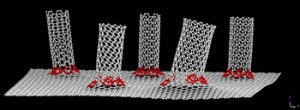Researchers at the University of Washington have published a study in the peer-reviewed, open access journal, Public Library of Science ONE (PLoS ONE), concerning their work to produce fibres that can deliver both contraceptives and anti-HIV drugs, according to a Nov. 30, 2012 news item on Nanowerk,
The only way to protect against HIV and unintended pregnancy today is the condom. It’s an effective technology, but not appropriate or popular in all situations.
A University of Washington team has developed a versatile platform to simultaneously offer contraception and prevent HIV. Electrically spun cloth with nanometer-sized fibers can dissolve to release drugs, providing a platform for cheap, discrete and reversible protection.
Hannah Hickey’s Nov. 30, 2012 University of Washington news release, which originated the news item, provides details,
“Our dream is to create a product women can use to protect themselves from HIV infection and unintended pregnancy,” said corresponding author Kim Woodrow, a UW assistant professor of bioengineering. “We have the drugs to do that. It’s really about delivering them in a way that makes them more potent, and allows a woman to want to use it.”
Electrospinning uses an electric field to catapult a charged fluid jet through air to create very fine, nanometer-scale fibers. The fibers can be manipulated to control the material’s solubility, strength and even geometry. Because of this versatility, fibers may be better at delivering medicine than existing technologies such as gels, tablets or pills. No high temperatures are involved, so the method is suitable for heat-sensitive molecules. The fabric can also incorporate large molecules, such as proteins and antibodies, that are hard to deliver through other methods.
…
They first dissolved polymers approved by the Food and Drug Administration and antiretroviral drugs used to treat HIV to create a gooey solution that passes through a syringe. As the stream encounters the electric field it stretches to create thin fibers measuring 100 to several thousand nanometers that whip through the air and eventually stick to a collecting plate (one nanometer is about one 25-millionth of an inch). The final material is a stretchy fabric that can physically block sperm or release chemical contraceptives and antivirals.
“This method allows controlled release of multiple compounds,” Ball said. “We were able to tune the fibers to have different release properties.”
One of the fabrics they made dissolves within minutes, potentially offering users immediate, discrete protection against unwanted pregnancy and sexually transmitted diseases.
Another dissolves gradually over a few days, providing an option for sustained delivery, more like the birth-control pill, to provide contraception and guard against HIV.
The fabric could incorporate many fibers to guard against many different sexually transmitted infections, or include more than one anti-HIV drug to protect against drug-resistant strains (and discourage drug-resistant strains from emerging). Mixed fibers could be designed to release drugs at different times to increase their potency, like the prime-boost method used in vaccines.
The electrospun cloth could be inserted directly in the body or be used as a coating on vaginal rings or other products.
Electrospinning has existed for decades, but it’s only recently been automated to make it practical for applications such as filtration and tissue engineering. This is the first study to use nanofibers for vaginal drug delivery.
While this technology is more discrete than a condom, and potentially more versatile than pills or plastic or rubber devices, researchers say there is no single right answer.
The citation and link to the article,
Drug-Eluting Fibers for HIV-1 Inhibition and Contraception by Cameron Ball, Emily Krogstad, Thanyanan Chaowanachan, Kim A. Woodrow (2012) PLoS ONE 7(11): e49792. doi:10.1371/journal.pone.0049792
Last month, the Bill and Melinda Gates Foundation awarded these researchers a $1M grant to pursue this work.
*ETA Dec.2.12: I erroneously used the word clothing in the headline. It’s now been corrected to ‘cloth’.
